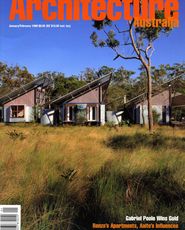
THE RENZO PIANO LOGBOOK
By Renzo Piano, preface by Kenneth Frampton, Thames & Hudson, $46.95.
On the cover of this substantial, square softback is the insouciant scribble which first announced Piano’s scheme for Sydney: the apartment and
office towers replacing Ken Woolley’s State Office Block. That scheme is documented as the last project in this retrospective of all the firm’s works since Piano’s 1966 debut with a mobile sulphur extraction factory at Pomezia, Italy. As might be expected of a publication from his building workshop, the graphic presentation is rational, consistent and thorough. But the special appeal is Piano’s own eloquence on architecture—“a socially dangerous art”— and the notions behind his projects.

A PLACE ON THE COAST
By Philip Cox with Janet Hawley; photography by Patrick Bingham-Hall, The Five Mile Press, $39.95.
Impatient Philip clipping roses, mixing fennel sauce and communing with nature from a kayak on the river? Don’t scoff: dozens of his friends have witnessed scenes like these at the Cox family property, Thubbul, near the Murrah River on the NSW south coast. In this book—a vanity exercise perhaps, but a charming and illuminating one with proceeds going to the National Trust in NSW—Cox calls on first-class photographer Patrick Bingham-Hall to help him capture the environmental and domestic joys
of his stretch of Tasman coast. As with earlier books, Cox writes with much understanding of history and geography, perception of detail, appreciation of nature and acute readings of people. Because the voice is first person, it is not clear what writing was done by his co-author Janet Hawley. Neither is it made clear what contributions were made to the property by Mrs Cox— former RAIA national president Louise—over the past quarter-century.

DESIGN IN AUSTRALIA 1880-1970
By Michael Bogle, Craftsman House, $80.
About time. Australia’s product design culture can’t mature without a platform of decent historical surveys—and here’s a volume which plugs important gaps. It is written by a perceptive scholar who has the advantage of being born in the northern hemisphere, so he’s not submerged in childhood sentiments which might skew judgments on the significance of local designers and their creations. During a decade-ish as curator of four
of Sydney’s historic museums, Bogle has researched the first (significant) 90 years of Australian merchandise … covering Ruskin’s early influence, then attempts to create a national spirit based on our unique “natural inventory”, moving on to the International Style, countered by a focus on Aboriginal
art from the twenties, to conclude with post-war affluence declared with Australian-made cars, home furnishings and appliances. While the graphic presentation is a bit dull, the writing is illuminating.

THE NEW OFFICE
By Francis Duffy, with contributions from Kenneth Powell, published by Conran Octopus, $100.
Former RIBA president Frank Duffy is one of a small coterie of architects internationally who see through the mud on what’s happening to the practice of architecture— check his 1992-1995 reports on the future of the UK profession. In this impressively illustrated hardback, he outlines the future of offices with convincing arguments developed from his own multi-national consultancy, DEGW, which is recognised as the world leader in office space planning. (It recently programmed the Sydney HQ of Lend Lease Interiors; a project case-studied in the book.) Duffy brings readers up to date with the whats and whys of fitout design theory in the telecommunications era: proposing a floor layout strategy where people come and go between hives (for individual processes), dens (for group processes), clubs (for informal transactions) and cells (for concentrated studies). The goal is to cut floor space and other costs while maximising productivity through efficient communication —and when this is got right, interior architects can do dress-ups. It’s clearly a key text for any practice that’s serious about the word ‘Interiors’ on its letterhead.

SYDNEY ARCHITECTURE
By John Haskell, photography by John Callanan, UNSW Press, $29.95.
The title sounds promising but the content is regrettably messy. Apart from an attractive cover, this volume fails all reasonable measures of a portable walking guide to buildings. The author’s considerable knowledge and photographer’s capabilities have been erased by scatterbrain strategies of editorial planning. A dire layout, littered with dinkuses which distract from Haskell’s delicate pen sketches, descends readers into confusion about what information’s where.
PERIODICALS
Form Technique Content 3/1997. Theme edition on the architecture of walls; fine mono graphics and photos; projects by Kahn, Predock, Piano, Miralles and Australians, plus Nield and Leon van Schaik on tectonics.
Architectural Theory Review No 3. Dull design mars a good collection of academic essays. Glen Hill and Snodgrass separately apply Heidegger; Xinong Xu considers Chinese typology, Chris Johnson thinks back to James Barnet.
NATSPEC Papers #1. Papers on technical aspects of concrete, masonry, steel and fibre-composites, fire safety, CAD and quality management. Well presented.
Notices written by Davina Jackson.















